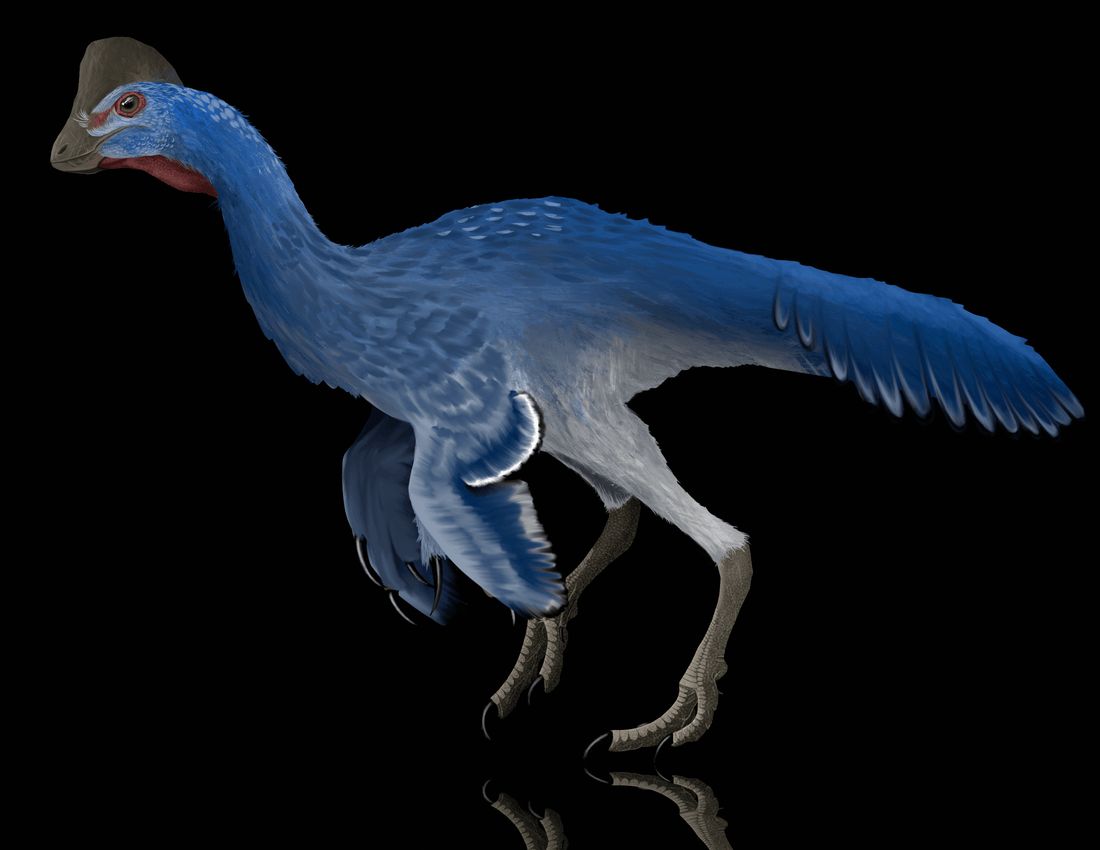
Anz-who? Anzu, that's who!
Share
Anzu wyliei is the largest and most complete North American oviraptorosaur thus far discovered, measuring 11’ long and around 600 lbs. Its massive size dwarfs its 6’ long North American relatives, Chirostenotes and Caenagnathus. However, even larger Anzu specimens likely existed based on findings of individual bones up to 20% larger than those in the scientific literature! Though discovered in South Dakota in 1998, it wasn't named as a new genus of dinosaur until 2014 by Lamanna et al. It has also been found in North Dakota. It lived at the end of the dinosaurs' reign, 67-66 million years ago, going extinct at the very end of the Cretaceous.

Anzu skeleton at the Rocky Mountain Dinosaur Resource Center
Anzu, Chirostenotes, and Caenagnathus form a family of dinosaurs called the caenagnathidae (pronounced ‘seen-a-nATH-id-ay,’ which means ‘recent jaw’), a group of big-headed, toothless dinosaurs that superficially resemble (if one overlooks the large tail and massively-clawed hands) flightless birds of today. The caenagnathidae are part of a group of dinosaurs known as the Oviraptorosauria, named after the first of its kind discovered, the ill-named Oviraptor, the "egg thief."
Oviraptor was, when discovered, believed to be predating upon eggs of Protoceratops. It took nearly 50 years for scientists to discover Oviraptors weren't "egg thieves" but actually tending to their own eggs! Science cannot change the name of Oviraptor thanks to the rules of zoological nomenclature, so the inappropriate name of "egg thief" lives on. Anzu helped confirm that oviraptorosaurs evolved in Asia ~75 million years ago and migrated to North America via a large land bridge. As Anzu is closely related to the Asian oviraptorosaurs, it may have had the birdlike behaviors of its cousins.

Oviraptorosaur on a nest
Many of the Asian oviraptorosaur species exhibit numerous bird characters. Some have been found sitting on top of nests, suggesting they were brooding their young like birds today. If they were brooding, it is probable they took some time to raise their young as well. Asian oviraptorosaurs have been found with quill knobs and pygostyle-like tails, indicating they had feathers. Anzu was likely feathered, at least on the arms. Fossil Crates had our paleoartist draw Anzu as being feathered throughout the body, but we have no direct evidence this was actually the case.
Anzu and the other oviraptorosaurs are not birds, nor are they on the evolutionary line that leads to birds, but their skeletons provide wonderful examples of convergent evolution. Anzu’s pygostyle-like tail and toothless beak outwardly resemble those of birds but, when looked at closely, are constructed differently than those of birds and thus converge on a similar, but not identical, end state.
Anzu had long and powerful arms and legs with large, sharp, narrow claws on its hand. Fossil Crates sells a cast of a 4" hand claw that includes artwork and an information sheet.


The prominent crest on Anzu's skull is quite similar to the casque of the cassowary. Its function is unknown, though all oviraptorosaurs appear to have one, with Anzu's being the largest and most elaborate known. Cassowary crests seem to be used to attract a mate. Considering how delicate the Anzu crest is, that seems to be what it is used for.

Anzu skull with massive crest, sclerotic ring (inside eyeball), and no teeth
It had a sclerotic ring, which consists of a series of bones inside the eyeball! These bones maintain the eye’s shape. Its large eyes suggest it had excellent vision.
One of the most amazing things about Anzu is it had no teeth but instead had a large, sharp beak. What did a dinosaur lacking teeth but possessing sharp claws on powerful arms and legs eat? Did it use its beak to crack open seeds, mollusks, and eggs? Was it like a roadrunner or an ostrich that ate insects, small reptiles, and mammals that it chased down with its speed and skewered with its claws? Was it an herbivore? It lived on the floodplains of the Western Interior Seaway. Perhaps it was catching fish and near-shore aquatic animals? Did it use its claws like a hook to “fish” out insects from trees by either tearing the tree’s limbs open or stabbing the claw into a tree and collecting insects like the primate called an aye-aye? No one knows for sure. I believe it was an omnivore and ate many different kinds of foods, a position that has some support as Anzu's jaw seemingly could chew similar to turtles and birds, many of which are known to eat a diverse range of items.
Dinosaurs never fail to amaze!
Thank you kindly,
BC